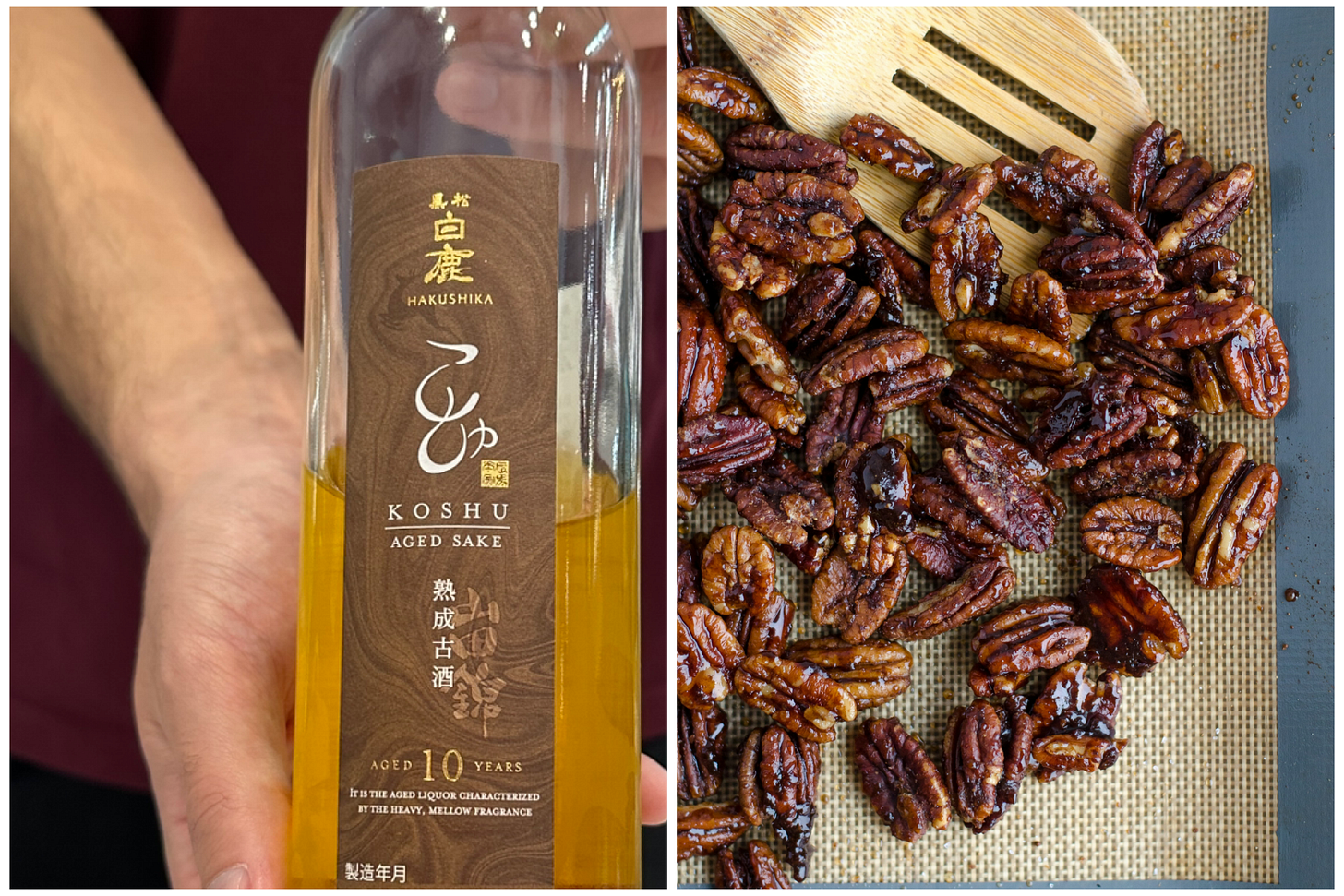Sake 101
The Magic of the Maillard Reaction
At this year’s ProWein, I was completely absorbed—not just by the wines of Hungary, Austria, Germany, and of course, sake, which were my main focus—but by something more subtle and seductive: aroma.
It kept appearing again and again—in vintage Champagne, and most surprisingly, in 10- and 20-year-old bottles of sake. That unmistakable scent of roasted nuts, browned sugar, toasted bread…There’s a simple, elegant explanation: The Maillard Reaction.
In a fascinating masterclass offered by the Japan Sake and Shochu Makers Association, we explored the world of aged sake and pairing, and it opened a door I haven’t stopped thinking about. Today, I’d love to share what I learned—along with a bit of my own research and experience.
📍 Written by Kazumi, a Japanese DipWSET, wine and sake educator.
What is the Maillard Reaction?
This is a chemical reaction between amino acids and reducing sugars, typically triggered by heat or extended time. It’s what gives browned foods their deeply flavorful, nutty, and toasty character.
You’ve already encountered it in everyday life—in the crust of freshly baked bread, grilled steak, roasted coffee beans, toasted nuts, seared mushrooms, or caramelized onions. But the Maillard Reaction isn’t just for cooking—it also quietly transforms wine, beer, sake, and even soy sauce, especially during aging.
In beverages, the Maillard Reaction doesn’t always require high heat, but it can occur slowly during bottle aging, contributing deep, savory, toasty, caramelized aromas. It also adds layers of warmth, umami, and complexity—a signature of age and elegance.
Here are a few key compounds created by the Maillard Reaction:
Sotolon: caramel, dried fruits, honey-like notes (think aged Champagne, Sherry, or Vin Jaune)
Pyrazines: roasted, earthy, nutty aromas—sometimes like hojicha tea
Melanoidins: contribute to browning and umami in aged sake, dark beer, miso
Furfural: caramel and almond notes found in toasted oak, sake, rum
Three Drinks, One Story: Time + Sweetness = Soul
To be more specific, you can find things like this.
Aged Champagne
In the post-disgorgement phase, residual sugar in the liqueur d’expédition interacts with yeast autolysis by-products, producing the signature aromas of aged Champagne, including toasted, nutty, and creamy aromas: brioche, almond, toasted bread, and vanilla.
Aged Sauternes
As Sauternes matures, it shifts from tropical and honeyed to something deeper: roasted pineapple, burnt sugar, dried apricot, spice. Sugars and acids slowly evolve into complex compounds linked to the Maillard Reaction—even without heat.
Aged Sake (Koshu)
Sake starts from a very different base (rice and koji mold), but after 10–20 years of aging, it arrives at a familiar place: caramel, soy sauce, toasted grain, roasted nuts. The Maillard magic unfolds quietly in sake’s sugar- and amino-rich matrix.
Sake 101: There’s no official definition of “aged sake” (Koshu), but many consider anything aged over three years to show noticeable transformation. Around five years, sake begins to develop a light amber hue, nutty aromas, and a smoother texture. At 10 to 20 years, it deepens into a rich amber color and reveals complex layers of soy sauce, burnt sugar, dried fruit, and umami-laden depth. Aging vessels vary—bottle, stainless steel, ceramic, or even oak—but regardless of the container, time works its quiet magic.
Featured Sake: Kuromatsu Hakushika Koshu 10-Year (Hyogo, 17% abv)
This koshu offers a deeply savory experience, beginning with a veil of umami-rich soy and unfolding into layers of marzipan, honey, toasted cashew, burnt sugar, candied fruit, brown sugar syrup, a touch of tonka bean, and more soy sauce.
The texture is rich, creamy, and almost dessert-wine-like—off-dry, yet balanced by fresh acidity and elevated by dense umami.
Above all, it displays the hallmarks of the Maillard Reaction: nutty toast, caramel, and warm spice, leading to a long and elegant finish.
The Pairing: Aged Sake & Caramelized Pecans
During the masterclass, this pairing was served: caramelized pecans with a 10-year-aged sake. At first, it made logical sense. Sweet nuts + toasted sake = good match. But when I tasted it? It wasn’t just good. It was beautiful.
The caramel shell of the pecans met the sake’s roasted, nutty warmth like they were made for each other. Each bite revealed new dimensions: marzipan, molasses, toasted almond, candied citrus.
Yes, it was technically sound. But emotionally, it was moving. Both sake and pecans had been shaped by the Maillard Reaction—one through fire, the other through time. Together, they created something quietly brilliant.
Conclusion
When you sip a glass of vintage Champagne and catch a hint of almond toast…
When a drop of Sauternes lingers with honey and spice…
When aged sake fills your senses with soy caramel and toasted nuts…
It’s the same story being told: Time transforms sweetness into soul. So next time you reach for a familiar bottle, consider stepping sideways. If you love aged wine, you might find aged sake just as captivating.
This is what Pairing World is all about—connecting flavors, cultures, and chemistry, one glass at a time. If you're curious to taste beyond borders, I’d love for you to subscribe and join me every Friday.
Now I’d love to hear from you—What’s your favorite “aged” aroma memory?
Feel free to subscribe for free or follow me on Instagram and LinkedIn.
See you next week 🥂
シャンパン、ソーテルヌ、熟成酒の共通点とは?
メイラード反応の魔法
今年のProWeinでは、ハンガリー、オーストリア、ドイツのワイン、そしてもちろん日本酒に夢中になっていた。もちろん、それらは私の主な関心事であったが、それ以上に、より繊細で魅惑的なものに夢中になっていた。それは「香り」である。
ヴィンテージ・シャンパンや、10年、20年ものの日本酒からも感じられる、ローストナッツ、ブラウンシュガー、トーストしたパンの香ばしい香り、そのシンプルなエレガントな香りを出すもの、メイラード反応。
日本酒造組合中央会が提供する魅力的なマスタークラスで、熟成した日本酒とペアリングの世界を探求し、考えさせられる扉を開いた。今日は、私が学んだこと、そして少しの私自身の研究と経験を共有したいと思う。
📍 執筆:ディップWSET、ワイン・日本酒講師の和美
メイラード反応とは?
アミノ酸と還元糖が熱や時間によって引き起こす化学反応だ。 こんがり焼けた食品に、ナッツのような風味や香ばしさ、トーストのような味わいを与える。
すでに日常生活の中で、焼き立てのパンの皮、グリルしたステーキ、ローストしたコーヒー豆、トーストしたナッツ、ソテーしたマッシュルーム、キャラメリゼした玉ねぎなどで、このメイラード反応を経験しているはず。 しかし、メイラード反応は料理のためだけにあるわけではない。ワイン、ビール、日本酒、さらには醤油でも、特に熟成中に、静かに変化をもたらす。
飲料においては、メイラード反応は必ずしも高温を必要とせず、瓶熟成中にゆっくりと起こり、深みのある芳ばしい香ばしい香りを生み出す。また、温かみ、うまみ、複雑さを加え、熟成と気品を象徴する。
メイラード反応によって生み出される主な化合物には以下のようなものがある。
ソトロン:カラメル、ドライフルーツ、蜂蜜のような香り(熟成したシャンパン、シェリー酒、ヴァン・ジョーヌの香り)
ピラジン:ロースト、土っぽい、ナッツのような香り。時にはほうじ茶のような香りも
メラノイジン:熟成した日本酒、黒ビール、味噌の褐色化と旨味に寄与
フルフラール:トーストしたオーク材、日本酒、ラム酒に含まれるカラメルとアーモンドの香り
3つの飲み物、1つのストーリー:時間+甘味=魂
より具体的に説明すると、このようなことが挙げられる。
熟成したシャンパン
デゴルジュマン後の段階では、添加する門出の酒に含まれる残留糖分が酵母の自己分解と相互作用し、ブリオッシュ、アーモンド、トーストしたパン、バニラなどのトースト、ナッツ、クリーミーな香りを伴う熟成したシャンパンの特徴的な香りを生み出す。
熟成したソーテルヌ
ソーテルヌが熟成するにつれ、トロピカルフルーツや蜂蜜の風味から、ローストしたパイナップル、焦がし砂糖、ドライアプリコット、スパイスといったより深みのある風味へと変化する。 熱を加えなくても、糖分と酸がゆっくりとメイラード反応と結びつき、複雑な化合物へと変化していく。
熟成した日本酒(古酒)
日本酒は、米と麹という全く異なる原料から造られるが、10~20年熟成させると、キャラメル、醤油、トーストした穀物、ローストしたナッツといったおなじみの風味になる。 メイラード反応の魔法は、糖分とアミノ酸が豊富な日本酒ならではの複雑さ。
日本酒入門:「熟成酒」の公式な定義はないが、多くの人は3年以上熟成したものは顕著な変化が見られると考えているようだ。5年ほど経つと、日本酒は淡い琥珀色になり、ナッツのような香りが加わり、より滑らかな舌触りになり、10年から20年経つと、さらに深い琥珀色になり、醤油、焦がし砂糖、ドライフルーツ、うま味の効いた奥行きといった複雑な層が現れる。熟成させる容器は、瓶、ステンレススチール、陶器、あるいはオーク樽など様々だ。
おすすめのお酒:黒松 白鹿 10年古酒(兵庫県、アルコール度数17%)
この古酒は、濃厚な旨味の醤油のヴェールから始まり、マジパン、蜂蜜、ローストしたカシューナッツ、焦がし砂糖、砂糖漬けの果物、黒糖シロップ、トンカ豆の風味、そしてさらに醤油の風味へと、幾重にも広がる味わい深い風味が広がる。
その舌触りは濃厚でクリーミー、デザートワインのようであり、ほのかに甘く、しかしフレッシュな酸味がバランスを整え、濃厚な旨味が味わいを高める。
そして何よりも、メイラード反応の特徴である、ナッツのトースト、カラメル、温かみのあるスパイスの風味が感じられ、長くエレガントな余韻へと続く点が美しい。
ペアリング:熟成酒とキャラメリゼしたペカン
マスタークラスで出されたペアリングは、カラメルピーカンナッツと10年熟成の日本酒だった。甘いナッツ+トーストした日本酒=理屈に合った良い組み合わせ。しかし、実際に味わってみると?ただ良いというだけでなく、素晴らしいものだった。
ピーカンナッツのカラメルコーティングが、日本酒のローストされたナッツのような温かさと出会うと、まるで互いのために作られたかのようにぴったりと合わさった。一口食べるごとに、新たな味わい、マジパン、糖蜜、ローストアーモンド、砂糖漬けの柑橘類が現れる。
技術的には理にかなっている。それ以上に感動的。日本酒もピーカンナッツも、メイラード反応によって形作られた。一方は火によって、もう一方は時間によって。この2つが組み合わさることで、静かなる傑作が生まれていた。
結論
ヴィンテージのシャンパンを口に含み、トーストの香りがほのかに感じられるとき...
ソーテルヌワインを口に含んだときに蜂蜜とスパイスの香りが長く残るとき...
熟成酒の醤油キャラメルとトーストしたナッツの香りが五感を満たすとき...
そこには同じストーリーが語られています。「時が甘さを魂に変える」というストーリー。次に馴染みのあるボトルを手に取るときには、一歩踏み込んでみて欲しい。熟成したワインが好きなワイン愛好家は、熟成日本酒も同じくらい魅力的に感じられるかもしれない。
さて、皆さんの「熟成」の香りに関する思い出のお気に入りはどれですか?
無料購読、InstagramやLinkedInでもフォローよろしくお願いします。
それではまた来週🥂
講師という立ち位置から一歩進んで、オランダで日本酒やワインを広めたいと思っています。何かお手伝いできることがあればお気軽にご連絡ください。




Thank you for your comment. I'm happy to share Japanese sake and will post one more post from now on, mostly about sake:)
Fascinating, and a lot of things I didn't know. Thank you.